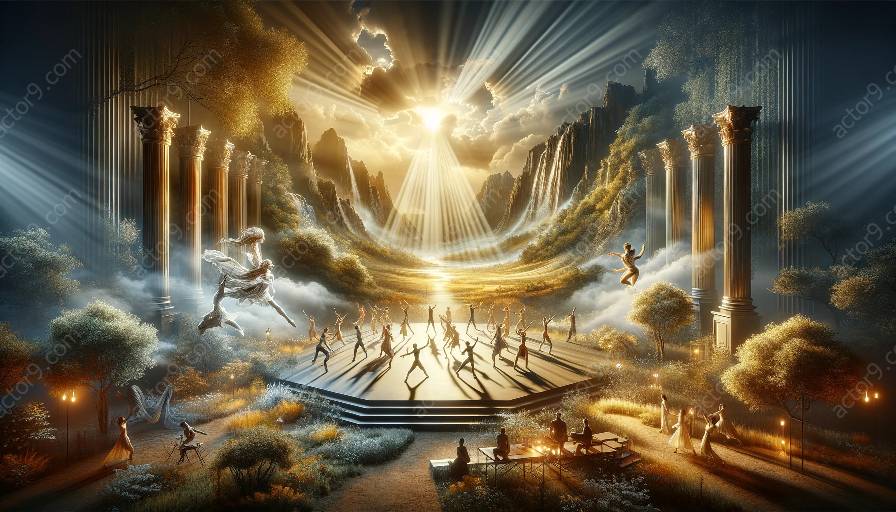Physical theatre, with its emphasis on the body's physical expression, evokes a wide range of emotions and psychological responses. Lighting plays a crucial role in shaping the audience's perception and intensifying the emotional impact of the performers' movements. By understanding the intricate relationship between lighting and physical theatre, it becomes evident how lighting can dramatically influence the storytelling and the audience's experience.
The Role of Lighting in Physical Theatre
In physical theatre, lighting serves as a powerful tool to set the mood, create atmospheres, and guide the audience's focus. By manipulating the intensity, color, and direction of light, lighting designers can enhance the dynamics of the performance, accentuating the performers' movements and gestures. With carefully crafted lighting designs, physical theatre productions can evoke specific emotional responses, heighten tension, or create moments of intimacy that resonate deeply with the audience.
Atmosphere Creation
Lighting design in physical theatre directly influences the overall atmosphere of the performance space. By utilizing different lighting techniques such as color washes, spotlights, or dynamic patterns, lighting designers can transform the stage into a versatile canvas that mirrors the emotional landscape of the narrative. For instance, warm, soft lighting may convey a sense of comfort and tenderness, while stark, harsh lighting can evoke tension and discomfort, intensifying the physical expression of the performers.
Emotional Impact
Emotional storytelling in physical theatre heavily depends on the visual and sensory stimuli provided to the audience, and lighting plays a pivotal role in this process. Through strategic use of light and shadow, the emotional nuances of the performers' movements are amplified, conveying subtle layers of meaning and depth. This heightened emotional resonance, facilitated by lighting, immerses the audience in the narrative and fosters a deeper connection with the performers' expressions.
Guidance of Focus
The strategic placement and manipulation of light sources can guide the audience's focus within the performance space. By illuminating key elements or performers, the lighting design can draw attention to specific moments, actions, or emotions, shaping the audience's perception and interpretation of the physical theatre piece. This intentional manipulation of focus contributes to a multidimensional viewing experience, allowing the audience to engage with the performance at various levels.
Psychological Effects of Lighting in Physical Theatre
Beyond its emotional impact, lighting in physical theatre also elicits psychological responses that significantly contribute to the audience's overall experience. The interplay between light and shadow, as well as the dynamics of illumination, triggers subconscious reactions, creating a captivating psychological environment that complements the physical expressions of the performers.
Symbolism and Metaphor
Lighting design often extends beyond its practical function and integrates symbolic and metaphorical elements that speak directly to the psyche of the audience. Metaphorical use of light and shadow can articulate subconscious themes and emotions, adding depth to the narrative and prompting introspective contemplation among viewers. Symbolic lighting creates a layer of storytelling that transcends the physical realm, resonating on an emotional and psychological level.
Temporal Flow and Rhythm
In physical theatre, lighting not only defines space but also manipulates time, contributing to the rhythm and temporal flow of the performance. Dynamic changes in lighting intensity and color can alter the perception of time, creating a sense of urgency, suspense, or tranquility. This manipulation of temporal perception influences the audience's psychological engagement with the narrative, shaping their emotional journey throughout the performance.
Perception and Reality
Lighting profoundly impacts the audience's perception of reality within the physical theatre context. By selectively illuminating certain elements and concealing others in shadow, the lighting design shapes the audience's understanding of the performance space, often blurring the boundaries between what is real and what is imagined. This interplay between perception and reality cultivates a psychological intrigue, prompting the audience to actively interpret the performance through a lens of emotional and cognitive resonance.
The Impact on Audience Experience
Ultimately, the emotional and psychological effects of lighting in physical theatre significantly enhance the audience's experience, providing a multi-sensory journey that transcends the boundaries of traditional theatrical storytelling. By engaging the visual, emotional, and psychological senses, lighting design in physical theatre invites the audience to immerse themselves in a rich tapestry of expression and interpretation, creating a profound and lasting impact.




































